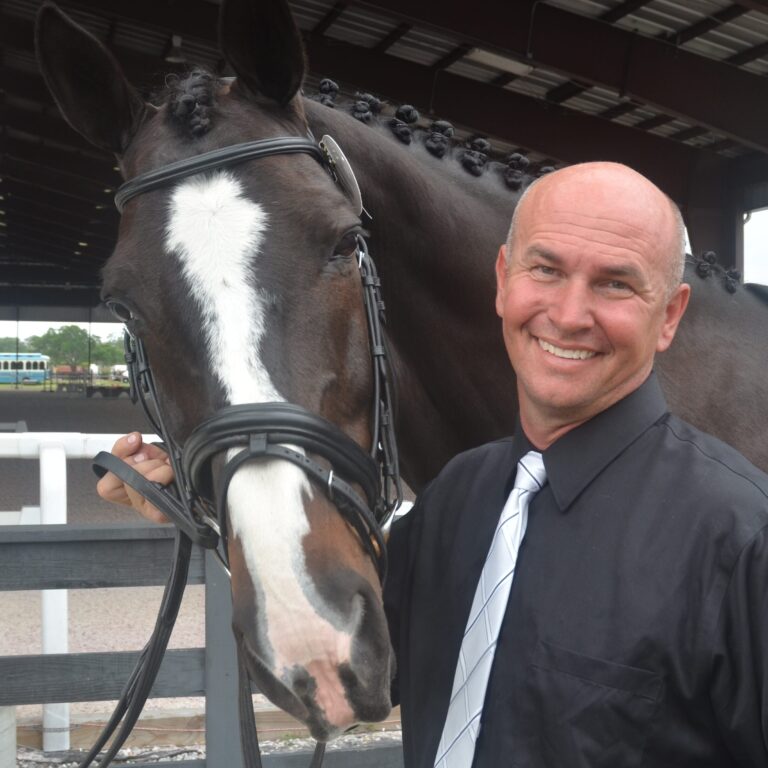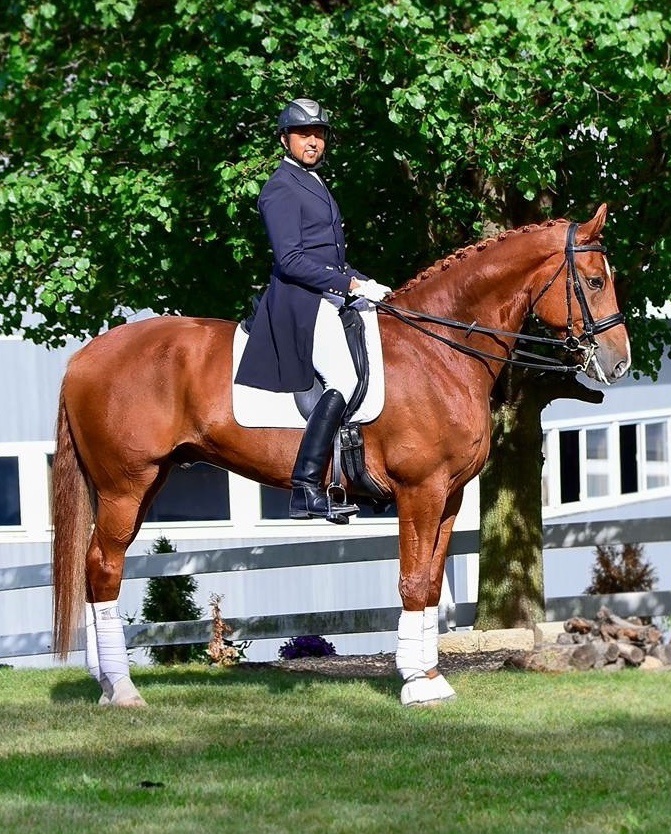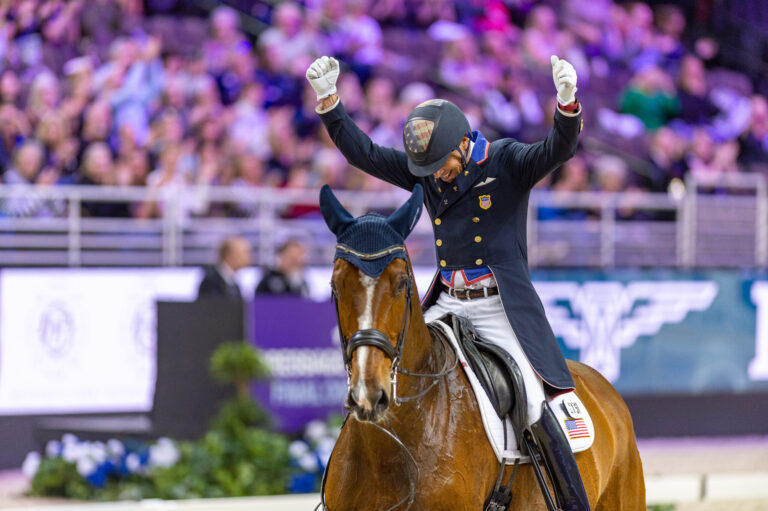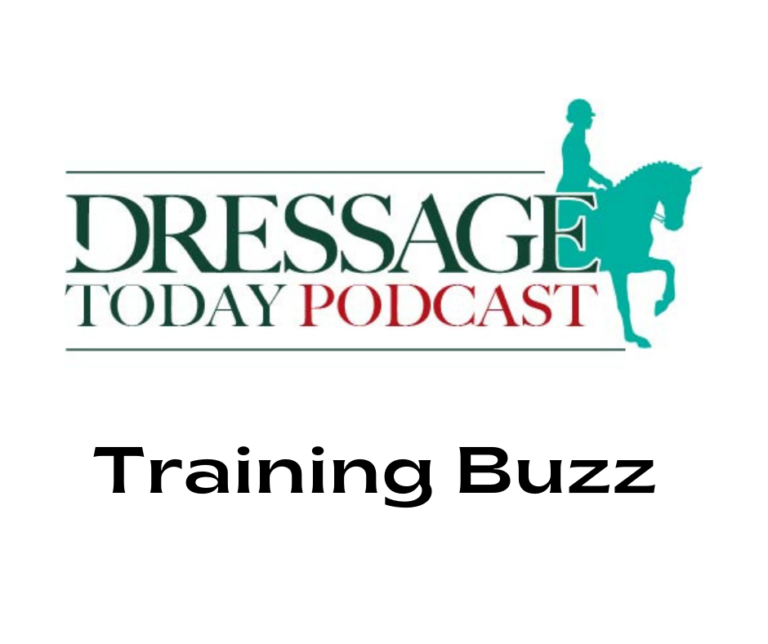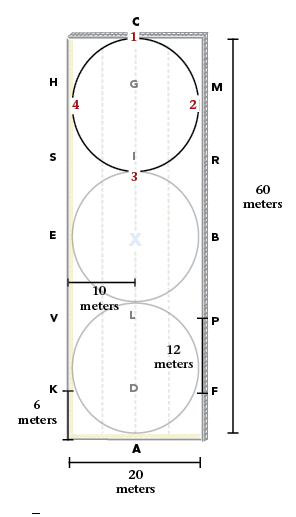
(Arnd Bronkhorst – arnd.nl
)
Don Johnson FRH is one of three horses featured in this series who is campaigned by the legendary German rider Isabell Werth. Currently the No. 1 dressage rider in the world, Werth is a five-time Olympian and holds the record for the most Olympic medals won by any equestrian athlete. She has ridden Don Johnson, a 17-year-old bay Hanoverian gelding owned by Madeleine Winter-Schulze, at 106 FEI-recognized competitions, and he’s won an impressive 48 times. Don Johnson has his own page on Werth’s website, where his photo is captioned this way: “Willful and explosive, but also elastic. How to get along with all of these characteristics and also channel them so that during each test the horse’s ability can be called upon reliably? That’s the challenge that Isabell loves in her daily work with all horses—and it’s the reason Don Johnson has a special place in her heart.”
Don Johnson’s international success has clear roots in his breeding: His pedigree on both sides includes sport-horse royalty. To guide us through a close look at this pedigree, we contacted USDF gold medalist Meg Williams who owns and trains from Oakwood Hanoverians in Lawrenceburg, Indiana. Williams, who has bred Hanoverian horses for more than 30 years, is also chair of the American Hanoverian Society’s (AHS) Mare and Stallion Committee. According to Williams, “When I look at Don Johnson’s pedigree, both up close and further removed, I see top performance horses and top-producing performance stallions throughout. Don Johnson’s sire, Don Frederico, is an excellent performance stallion, who himself had an impressive FEI-level career and was an outstanding producer. He has so many offspring now that are in the FEI ring both nationally and internationally. They’re exceeding even the very high expectations that the sport-horse world has for Don Frederico progeny.”
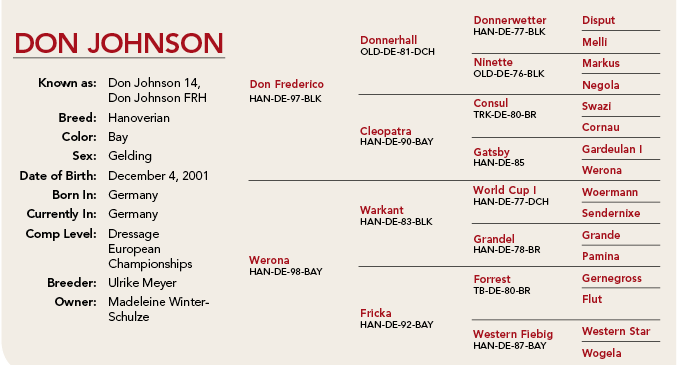
Williams emphasizes Don Frederico horses are known for powerful hindquarters and lots of elasticity in their movement. He passes on the type of movement that’s desired at the upper levels of the sport today, with lots of knee action, lift through the shoulder and overall expression. She explains Don Frederico is also known to produce horses who are dark in color and, likely because of the higher percentage of Thoroughbred and Trakehner blood, tend to have spark, intelligence and a drive to work. While Williams acknowledges horses of this line may or may not be amateur-friendly due to that inherently high motivation, she believes it’s these exact characteristics that allow top dressage horses to meet the performance demands of upperlevel competition. (Williams is a fan of these bloodlines. In fact, her own breeding program currently stands a Don Frederico son, the Elite Hanoverian stallion Dubarry.)
On the dam side of Don Johnson’s pedigree, we take note of the W-line, a foundation Hanoverian line that through damsire Warkant goes back to World Cup and Woermann. These influential Hanoverian sires trace back to Wöhler, a stallion known for his action trot. According to Williams, “The W-line is tried and true. It’s really one of the foundation lines for the Hanoverians, meaning that Wöhler and his offspring have really defined a distinct bloodline within the breed. This line is known for good rideability and disposition as well as expressive movement. Warkant stands out as a very nice stallion who was unable to complete his performance testing due to injury. He was far enough along in the inspection process that he was approved for breeding. He is known to be a mare producer, meaning his daughters are very highly sought after as broodmares.” Williams explains that Warkant’s daughters have proven themselves in the quality of horse they produce, perhaps more so than his sons have. She points out that it’s considered a nick (see sidebar at bottom) to cross a Donnerhall stallion with a Warkant mare: Both lines are known for expressive movement and are popular among dressage horse breeders.
Note that Weltmeyer, widely considered one of the most influential Hanoverian stallions of the last 50 years is a half-brother to Don Johnson’s sire Warkant. Both are sons of World Cup. According to Williams, Warkant was a heavy horse who tended to produce horses heavier than himself. In contrast, Weltmeyer did not have this same tendency to produce heavier horses because his dam line was influenced by the Trakehner Absatz.
An analysis of Don Johnson’s pedigree would be incomplete without acknowledging that he is 34.53 percent Thoroughbred. George Walker, an AHS stallion and breed inspection judge, operates Middlefield Farm in Blythewood, South Carolina, together with his wife, Catherine. Walker was raised with Thoroughbreds and has been part of both the Thoroughbred and Hanoverian breeding world for decades. He explains the importance of the Thoroughbred influence on Don Johnson’s pedigree: “When I look at Don Johnson’s pedigree, what strikes me is that the ratio of Thoroughbred blood stays quite consistent as you go back generations. He’s 34.53 percent Thoroughbred, his sire 39.09 percent, his dam Werona 34 percent. I like that because often in breeding, consistency is the name of the game. When you see this consistent percentage of Thoroughbred blood carried through on both sides of the pedigree, it elevates the chances of creating the type that you want.” By “type” Walker is referring to the concept of a lighter, more refined sport horse who has cohesive conformation and a uniform look. In type, today’s sport horse should represent a balance of the warmblood’s good bone and ground-covering movement with the Thoroughbred’s more refined head, longer legs and neck, clean legs and stamina.
Walker points out that Warkant, the dam sire, produced some very heavy horses (he’s less than 10 percent Thoroughbred), but to balance that, Don Johnson’s dam was out of Fricka, who was 64 percent Thoroughbred. According to Walker, “It’s clear the breeder took into consideration that Warkant was producing bigger, heavier type horses and chose to lighten this cross by adding Thoroughbred blood.” In this way, Walker says the inclusion of carefully selected Thoroughbreds into warmblood breeding programs can provide the sport horse with a “go button,” a drive to work, endurance, hard bone and beautiful, well-fluted legs. Don Johnson is a case in point, demonstrating how infusion of Thoroughbred blood can help produce a warmblood capable of the highest levels of performance.
According to Walker: “It’s interesting to note that Isabell Werth is an upper-level rider who makes her own horses. She’s a trainer. She is willing to get on them early, she knows what she wants and likes. She knows she needs an alert, responsive horse. So, here we have the No. 1 rider in the world, who brings along her own horses through the levels, with a horse who has a well-balanced pedigree of older, proven warmblood lines and Thoroughbred blood. The influence of the ‘blood’ horse is still a valuable part of the recipe.” Walker adds that when we’re looking at the performance requirements for an FEI-level dressage horse like Don Johnson, it’s certainly not speed that is the most important quality being drawn from Thoroughbred outcrosses. Rather, it’s a higher energy level and working drive that are needed for the upper-level work.
Williams makes a similar point: “As a breeder who is also a rider, I recognize horse selection is definitely pedigree-driven, but these are, ultimately, riding horses and we need to look first and foremost at how they perform. So there has to be high rideability and they have to want to do the work. Likewise, conformation is very important but then, to some extent, ‘pretty is as pretty does.’ Don Frederico, for example, is known for not always producing the cleanest legs on horses. But yet his offspring stand up and with-stand the FEI heavy-duty work. Also, though I am a breeder and value breeding, as a rider, I have to comment that the matching of the right horse to the right rider is as important, if not more important, than the pedigree.”
In Don Johnson and Isabell Werth, a fantastic match has helped elevate both horse and rider to the highest performance honors of our sport.
A ‘Nick’: Donnerhall Stallion and Warkant Mare
According to Hanoverian breeder Meg Williams, crossing a Donnerhall stallion with a Warkant mare is considered a “nick” by sport-horse breeders. (A nick? No less a source than Wikipedia defines a nick as a breeding term/practice that refers to “specific affinities of stallions of one male line for mares from other sire lines.” In other words: a cross that breeders believe will reliably produce desirable offspring. (Because nicks are frequently repeated crosses, their off-spring can significantly influence the development of a breed.)
Kyle Karnosh, an American breeder, points out that crossing a Donnerhall stallion with a Pik Bube I mare is another well-known nick. While this cross doesn’t appear in Don Johnson’s pedigree, it did produce the famous Oldenburg stallion Don Schufro, a leading sire of Grand Prix competitors, including Isabell Werth’s mare Weihegold OLD (currently ranked No. 1 in the world).
In fact, the exceptional influence of Donnerhall becomes apparent even by looking at the small sampling of 11 horses we’re featuring in this column. He appears in the pedigree of six out of 11 horses. The cross of a Donnerhall stallion and W-line mare appears in two pedigrees (Desperados FRH and Don Johnson FRH) while the specific Donnerhall and Pik Bube I nick appears in three (Showtime FRH, Cassidy DW and Weihegold OLD).
The State Stud at Celle
Located in Lower Saxony, just north of Hanover, Germany, the State Stud at Celle is a government-owned and managed horse-breeding operation that has been in existence since 1735. Don Frederico stands there along with 119 other stallions of diverse warmblood, Thoroughbred or Anglo-Arab breeding.
Initially, the purpose of the State Stud was to provide local horse breeders across Germany with high-quality stallions, at a time when the primary use of horses was for agriculture or militia. According to Ulrich Hahne, deputy breeding manager for the Hannoveraner Verband, “The relationship between the State Stud at Celle and the Hannoveraner Verband is really close, even though these are two different organizations. The State Stud established the Hanoverian breed and oversaw the breed until the Hanoverian studbook was founded in 1888.”
In the 1960s, as the focus of warmblood breeding shifted to the sport horse, the State Stud also shifted its attention in this direction. For many years, the State Stud had priority at annual stallion inspections and could choose before the public which stallions it wished to add to its breeding barn. According to Hanoverian breeder Meg Williams, “The State Stud no longer has an exclusive first priority to obtain the very best horses. Though they still do have amazing horses, the Stud now has to go up against the private breeder/owner who may have the budget to outbid them. Years ago and still today in some sense, it was prestigious and a privilege for local breeders to have their horse bought by the State Stud. This may be changing a little due to the influence of the more open market.”
Breed inspection judge George Walker also points out that the influence of the State Stud is still vital but has changed greatly. “To understand its cultural significance, you have to look back to the days where the location of the mares largely determined which stallion they would be bred to. In the days before shipped semen, mares were bred to the stallion who happened to be located at the farm down the road. Back then, the State Stud at Celle controlled where stallions were placed geographically and how long they stayed in that region. The head of the State Stud had enormous influence. He was able to say, ‘This stallion has been in this area long enough. He’s running into too many of his daughters now, so we need to move him over to another part of the country.’”
Walker points out that if you go far enough back you can even see the influence of regional topography on the horses preferred and produced in certain regions. In sandy regions, you had horses with less knee action. In Holstein, where horses were plowing fields of mud, the horses that would pick their knees up higher were more valued and therefore bred. Horse breeding in Germany has always had regional flair, and the State Stud at Celle has played an important role in shaping that history, most especially for the Hanoverian breed.
Today, in addition to housing 120 breeding stallions and shipping semen worldwide, the State Stud hosts cultural events such as the renowned Stallion Parade, annual festivals and a Christmas market.


